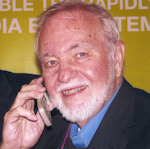Robert Metcalfe and his associates invented Ethernet in 1972 (see “Ethernet Prepositions”). The original Ethernet was a coax bus topology with a bit rate of 2.94 Mbits/s. During the next 10 years, it evolved into a 10-Mbit/s coax bus, and a frame format and protocol emerged.
In 1983, the IEEE standardized this 10-Mbit/s version as 802.3 and designated it as 10Base5. It defined the physical-layer (PHY) and media-access-control (MAC) layers of the network. The medium was RG-8/U coax, generally called thicknet. In 1985, a version using RG-58/U coax (thinnet) was defined.
During the early years of its use as a localarea network (LAN), Ethernet competed with several other technologies, most prominently ARCNET, a token coax bus, and IBM’s Token Ring of twisted pair. But Ethernet’s proponents kept making improvements and additions that sustained its popularity for a wide range of networking applications.
The big change came with the 1987 version, 802.3j, which specified low-cost unshielded twisted pair (UTP) as the medium. The designation was 10BaseT. Unshielded twisted pair (UTP) with its RJ-45 connectors was cheaper and easier to work with than coax, so 10BaseT soon became the LAN of choice, gradually edging out the competition.
Another big breakthrough came in 1995 with the 802.3u standard, which defined three versions of a 100-Mbit/s data-rate technology. The 100BaseTX version soon became the mainstay of enterprise LANs everywhere. It used CAT5 UTP, and this socalled 10/100 version of Ethernet is still the anchor of the technology.
But Ethernet wasn’t through yet. Faster, smaller semiconductors and other technologies soon made it possible to go way beyond 10/100. A 1-Gbit/s version was developed and standardized in 1998 as 802.3z. This fiber version was supplemented by a UTP version in 1999 as 802.3ab and dubbed 1000BaseT.
Since then, the technology has improved at a furious pace. The latest versions run at 10 Gbits/s. There are multiple fiber and UTP versions as well as coax and backplane versions. Other developments have kept Ethernet at the head of the pack, too. Currently, it’s without a doubt the only remaining LAN technology in use. And due to its high speed and other improvements, its use is rapidly extending into the metropolitan and widearea networks that were once implemented with ATM over T1 and DS3 lines as well as Sonet/SDH fiber networks.
Ethernet uses an access method called carrier- sense multiple-access/collision detection (CSMA/CD). Bus nodes use this arbitration method to access the network. Each node listens to the bus and then transmits if no one is using the bus. If another carrier (transmission) is sensed, the node waits until the bus is free. Collisions occur when two or more nodes try to access the bus simultaneously. The nodes then back off and retransmit at random intervals.
This means the bus, being a shared medium, causes the maximum data rate to be divided or shared depending on how many users are trying to access the bus. The throughput is lower by that factor. Data is transmitted in frames like those shown in the figure.
The table summarizes some of the latest standards of interest (see “Recent Significant Ethernet Standards”). The most exciting include the next speed increments to 40 and ultimately 100 Gbits/s.
